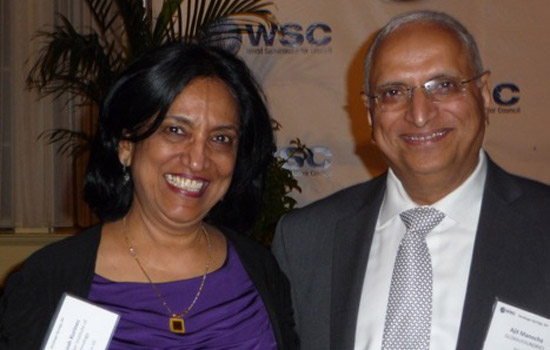Microelectronic engineering faculty takes steps to expand influence globally
Industry leaders focus on ways to further the $300 billion semiconductor industry at the World Semiconductor Council meeting
Provided by RIT microelectronic engineering
The World Semiconductor Council event was an opportunity for faculty-researchers such as Santosh Kurinec, left, professor of microelectronic engineering, and semiconductor industry leaders such as Ajit Manocha, chief executive officer of Global Foundries, to meet and discuss future collaborations.
Nearly $6 billion has been invested to support the growing microelectronics and semiconductor industry in New York state. The return on investment has resulted in nearly 1,200 high-tech jobs. More are expected in the future through regional development initiatives across the state, many supported by its colleges and universities.
Rochester Institute of Technology has provided microelectronic engineering graduates to national and international semiconductor companies since the program was established in 1982. It has also provided hands-on training for entry-level workers for the growing industry that has become an economic anchor for the state.
Faculty from RIT’s microelectonic engineering program participated in the recent annual meeting of the World Semiconductor Council May 21-25 in Saratoga Springs, N.Y., as a means to expand contributions to the industry by way of its academic, research and training support. The international organization is comprised of the U.S. Semiconductor Industry Association along with its European and Asian counterparts. Attendees were primarily chief executive officers from more than 30 major semiconductor corporations to discuss the $300 billion global semiconductor industry, its growth, emerging trends, trade agreements and opportunities for mutual collaboration and research initiatives.
Professors Robert Pearson, Santosh Kurinec and Michael Jackson from RIT’s Kate Gleason College of Engineering met with representatives of semiconductor companies and various officials from New York’s economic development agencies to discuss collaborative opportunities. Ian Steff, Semiconductor Industry Association vice president, global policy and technology partnerships, who also serves an advisory board member of the microelectronic engineering program, arranged the opportunity for RIT.
“We’ve had a long relationship with the Semiconductor Industry Association. Participating at this event gave us the opportunity to showcase the microelectronics program and our graduates who are currently working in this industry and those who will in the future,” Kurinec says.
Steff adds: “The Semiconductor Industry of America was pleased to provide an opportunity for RIT to showcase the good work of its distinguished faculty and students before leading worldwide semiconductor executives. As Lt. Gov. Robert Duffy referenced in his address before the council, leading academic and research institutions like RIT have contributed significantly to the state of New York’s ability to attract multi-billion dollar research and manufacturing investments.”
The World Semiconductor Council hosts an annual international meeting at the chief executive officer level and makes recommendations to governments and authorities from the six participating regions on behalf of the worldwide industry to encourage investment in education, research and development, and traditional infrastructure improvements, and to help secure the nation’s economic and national security. Meetings are hosted in the U.S. once every six years, and participants showcase the host region through industry dinners and receptions, interaction with government and state officials, site visits to local universities, and other areas relevant to the semiconductor industry.
“The semiconductor industry is continuing to grow and evolve globally and across New York. Working with the Cuomo Administration, Global Foundries and our many regional partners to host such an important industry event gives us the opportunity to highlight our regional technology assets and success stories to a critically important global audience,” Michael Tucker, president and chief information officer of the state’s Center for Economic Growth, told meeting participants.







